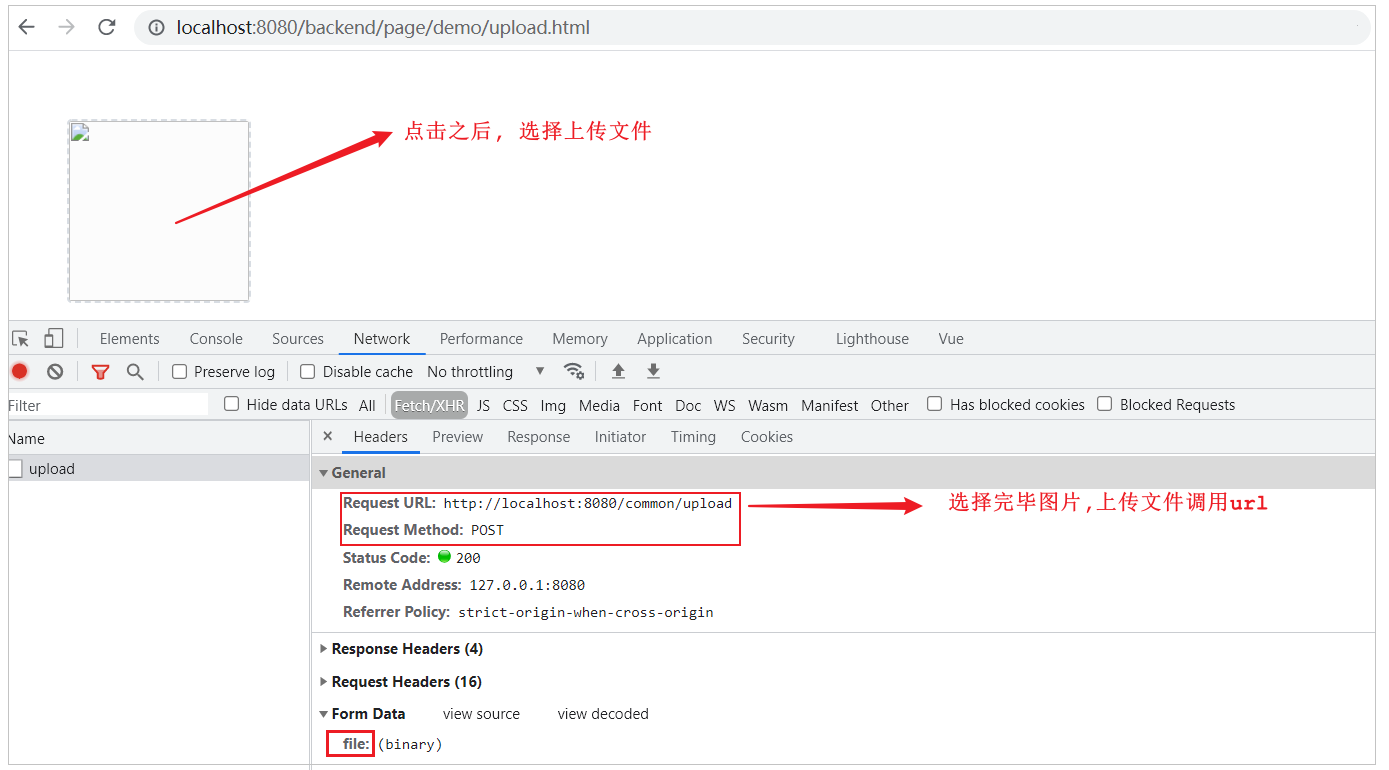1. 上传功能模块
1.1 上传概述
文件上传,也称为upload,是指将本地图片、视频、音频等文件上传到服务器上,可以供其他用户浏览或下载的过程。

文件上传时,对页面的form表单有如下要求:
| 表单属性 | 取值 | 说明 |
|---|---|---|
| method | post | 必须选择post方式提交 |
| enctype | multipart/form-data | 采用multipart格式上传文件 |
| type | file | 使用input的file控件上传 |
1.2 前端介绍
1). 简单html页面表单
<form method="post" action="/common/upload" enctype="multipart/form-data"><input name="myFile" type="file" /><input type="submit" value="提交" />
</form>2). ElementUI中提供的upload上传组件
目前一些前端组件库也提供了相应的上传组件,但是底层原理还是基于form表单的文件上传。

1.3 服务端介绍
服务端要接收客户端页面上传的文件,通常都会使用Apache的两个组件:
-
commons-fileupload
-
commons-io
而Spring框架在spring-web包中对文件上传进行了封装简化代码,只需要在Controller的方法中声明一个MultipartFile类型的参数即可接收上传的文件。
1.4 下载介绍
文件下载,也称为download,是指将文件从服务器传输到本地计算机的过程。通过浏览器进行文件下载,通常有两种表现形式:
1). 以附件形式下载,弹出保存对话框,将文件保存到指定磁盘目录

2). 直接在浏览器中打开
通过浏览器进行文件下载,本质上就是服务端将文件以流的形式写回浏览器的过程。

1.5 上传功能模块逻辑分析
1.3.1 前端代码分析
对于前端页面文件上传,可以使用ElementUI提供的上传组件,将其拷贝到项目的目录(resources/backend/page/demo)下,启动项目,访问上传页面。
<!DOCTYPE html>
<html lang="en">
<head><meta charset="UTF-8"><meta http-equiv="X-UA-Compatible" content="IE=edge"><meta name="viewport" content="width=device-width, initial-scale=1.0"><title>文件上传</title><!-- 引入样式 --><link rel="stylesheet" href="../../plugins/element-ui/index.css" /><link rel="stylesheet" href="../../styles/common.css" /><link rel="stylesheet" href="../../styles/page.css" />
</head>
<body><div class="addBrand-container" id="food-add-app"><div class="container"><el-upload class="avatar-uploader"action="/common/upload":show-file-list="false":on-success="handleAvatarSuccess":before-upload="beforeUpload"ref="upload"><img v-if="imageUrl" :src="imageUrl" class="avatar"></img><i v-else class="el-icon-plus avatar-uploader-icon"></i></el-upload></div></div><!-- 开发环境版本,包含了有帮助的命令行警告 --><script src="../../plugins/vue/vue.js"></script><!-- 引入组件库 --><script src="../../plugins/element-ui/index.js"></script><!-- 引入axios --><script src="../../plugins/axios/axios.min.js"></script><script src="../../js/index.js"></script><script>new Vue({el: '#food-add-app',data() {return {imageUrl: ''}},methods: {handleAvatarSuccess (response, file, fileList) {this.imageUrl = `/common/download?name=${response.data}`},beforeUpload (file) {if(file){const suffix = file.name.split('.')[1]const size = file.size / 1024 / 1024 < 2if(['png','jpeg','jpg'].indexOf(suffix) < 0){this.$message.error('上传图片只支持 png、jpeg、jpg 格式!')this.$refs.upload.clearFiles()return false}if(!size){this.$message.error('上传文件大小不能超过 2MB!')return false}return file}}}})</script>
</body>
</html>http://localhost:8080/backend/page/demo/upload.html
页面效果如下:

在上述的浏览器抓取的网络请求中,上传文件的调用url,在哪里配置的呢,这个时候,我们需要去看一下前端上传组件。

虽然上述是ElementUI封装的代码,但是实际上最终还通过file域上传文件,如果未指定上传文件的参数名,默认为file。

1.6 上传服务端代码逻辑
# 编写文件上传的方法, 通过MultipartFile类型的参数即可接收上传的文件, 方法形参的名称需要与页面的file域的name属性一致。
1). 获取文件的原始文件名, 通过原始文件名获取文件后缀
2). 通过UUID重新声明文件名, 文件名称重复造成文件覆盖
3). 创建文件存放目录
4). 将上传的临时文件转存到指定位置
2 下载功能模块
2.1 前端代码
文件下载,前端页面可以使用<img>标签展示下载的图片。
<img v-if="imageUrl" :src="imageUrl" class="avatar"></img>解析通过<img>标签如何展示图片数据具体的流程:

在文件上传成功后,在 handleAvatarSuccess 方法中获取文件上传成功之后返回的数据(文件名),然后调用 /common/download?name=xxx 进行文件的下载。在这里,如果想让上传的照片能够在页面展示出来,所以需要在服务端将文件以流的形式写回浏览器。
2.2 下载功能模块逻辑分析
# 在 CommonController 中定义方法download,并接收页面传递的参数name,然后读取图片文件的数据,然后以流的形式写回浏览器。
1). 定义输入流,通过输入流读取文件内容
2). 通过response对象,获取到输出流
3). 通过response对象设置响应数据格式(image/jpeg)
4). 通过输入流读取文件数据,然后通过上述的输出流写回浏览器
5). 关闭资源
3 上传与下载服务端代码实现
1). application.yml (需要在application.yml中定义文件存储路径 )
server:# 端口设计port: 8080
spring:application:# 应用名称(可选)name: reggie_take_outdatasource:# 数据集druid:driver-class-name: com.mysql.cj.jdbc.Driverurl: jdbc:mysql://localhost:3306/reggie?serverTimezone=Asia/Shanghai&useUnicode=true&characterEncoding=utf-8&zeroDateTimeBehavior=convertToNull&useSSL=false&allowPublicKeyRetrieval=trueusername: rootpassword: 123456
mybatis-plus:configuration:#在映射实体或者属性时,将数据库中表名和字段名中的下划线去掉,按照驼峰命名法映射map-underscore-to-camel-case: truelog-impl: org.apache.ibatis.logging.stdout.StdOutImplglobal-config:db-config:# ID生成策略:ASSIGN_ID:可以在分布式的情况下使用,生成的是Long类型的数字,可以排序性能也高,但是生成的策略和服务器时间有关,如果修改了系统时间就有可能导致出现重复主键id-type: ASSIGN_IDreggie: # 需要在application.yml中定义文件存储路径path: D:\Java-Pro\reggie_take_out\file\2). CommonController
代码实现:
package com.itheima.reggie.controller;import com.itheima.reggie.common.R;
import lombok.extern.slf4j.Slf4j;
import org.springframework.beans.factory.annotation.Value;
import org.springframework.web.bind.annotation.*;
import org.springframework.web.multipart.MultipartFile;import javax.servlet.ServletOutputStream;
import javax.servlet.http.HttpServletResponse;
import java.io.File;
import java.io.FileInputStream;
import java.io.FileNotFoundException;
import java.io.IOException;
import java.util.UUID;/*** Description: 文件的上传和下载* @date 2022/8/17 9:55*/@RestController
@RequestMapping("/common")
@Slf4j
public class CommonController {@Value("${reggie.path}")private String basePath;@PostMapping("upload")public R<String> upload(MultipartFile file){ // 这个名字必须和前端页面的name一样/**@Description: 文件上传* @version v1.0* @author LiBiGo* @date 2022/8/17 10:31*/// file 是一个临时文件 需要转存,不然运行结束自动删除log.info(file.toString());// 原始文件名String originalFilename = file.getOriginalFilename();// 获得原文件后缀String suffix =originalFilename.substring(originalFilename.lastIndexOf("."));// 使用UUID重新生成文件名,防止文件名称重复String fileName = UUID.randomUUID().toString() + suffix;// 创建目录对象File dir = new File(basePath);// 判断当前目录是否存在if(!dir.exists()){// 目录不存在,需要创建dir.mkdir();}try {file.transferTo(new File(basePath+fileName));} catch (IOException e){e.printStackTrace();}return R.success(fileName);}@GetMapping("/download")public void download(String name , HttpServletResponse response){/**@Description: 文件下载* @version v1.0* @author LiBiGo* @date 2022/8/17 10:31*/try {//输入流,通过输入流读取文件内容FileInputStream fileInputStream = new FileInputStream(new File(basePath + name));//输出流,通过输出流将文件写回浏览器ServletOutputStream outputStream = response.getOutputStream();response.setContentType("image/jpeg"); // 设置响应的文件格式,也可以不设置int len = 0;byte[] bytes = new byte[1024];while ((len = fileInputStream.read(bytes)) != -1){outputStream.write(bytes,0,len);outputStream.flush();}//关闭资源outputStream.close();fileInputStream.close();} catch (Exception e) {e.printStackTrace();}}
}









)

)





life...)

